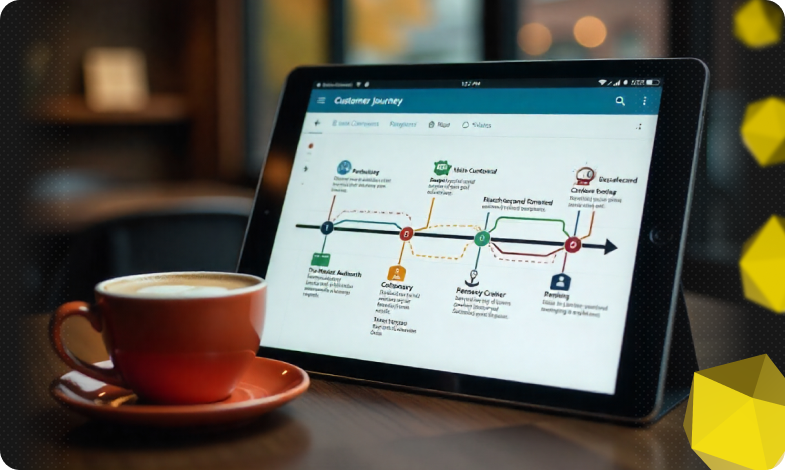Content of the article
- /01 What is market segmentation?
- /02 Goals and objectives of market segmentation
- /03 Principles of successful market segmentation
- /04 Advantages and disadvantages of market segmentation
- /05 Key criteria for customer segmentation
- /06 Stages of market segmentation
- /07 Developing marketing strategies based on segmentation
- /08 Cost and profitability of market segmentation
- /09 Examples of how market segmentation is used
- /10 Conclusion


Successful marketing starts with a deep understanding of the customer. Without knowing the needs and motivations of your audience, it’s impossible to set the right price, choose the best communication channel, and create a product that will really work in the market. Market segmentation helps to divide the total audience into distinct groups, each of which has its own characteristics and needs. In this guide, we’ll look at what segmentation is, what types of market segments exist, and share practical tips and examples.
What is market segmentation?
Market segmentation is a systematic approach to dividing the total audience into smaller, homogeneous groups of customers. Each target audience brings together people with similar needs, habits, and willingness to pay a certain price. This approach allows you to better understand who your customer is and create the most relevant offers for them.
It is important to understand! Market segmentation is not a one-time event, but a continuous process of analyzing the market and audience behavior. Only with regular review of the target audience can you respond to changes in customer demands in a timely manner and remain competitive.
Goals and objectives of market segmentation
Market segmentation is the basis of an effective trading strategy. It allows you not just to «shoot for the moon» but to target the most promising consumer groups. To make this tool really work, you should clearly define the purpose of segmentation and the business tasks it is supposed to solve.
Identify key goals
Before you start analyzing the market, answer the following questions.
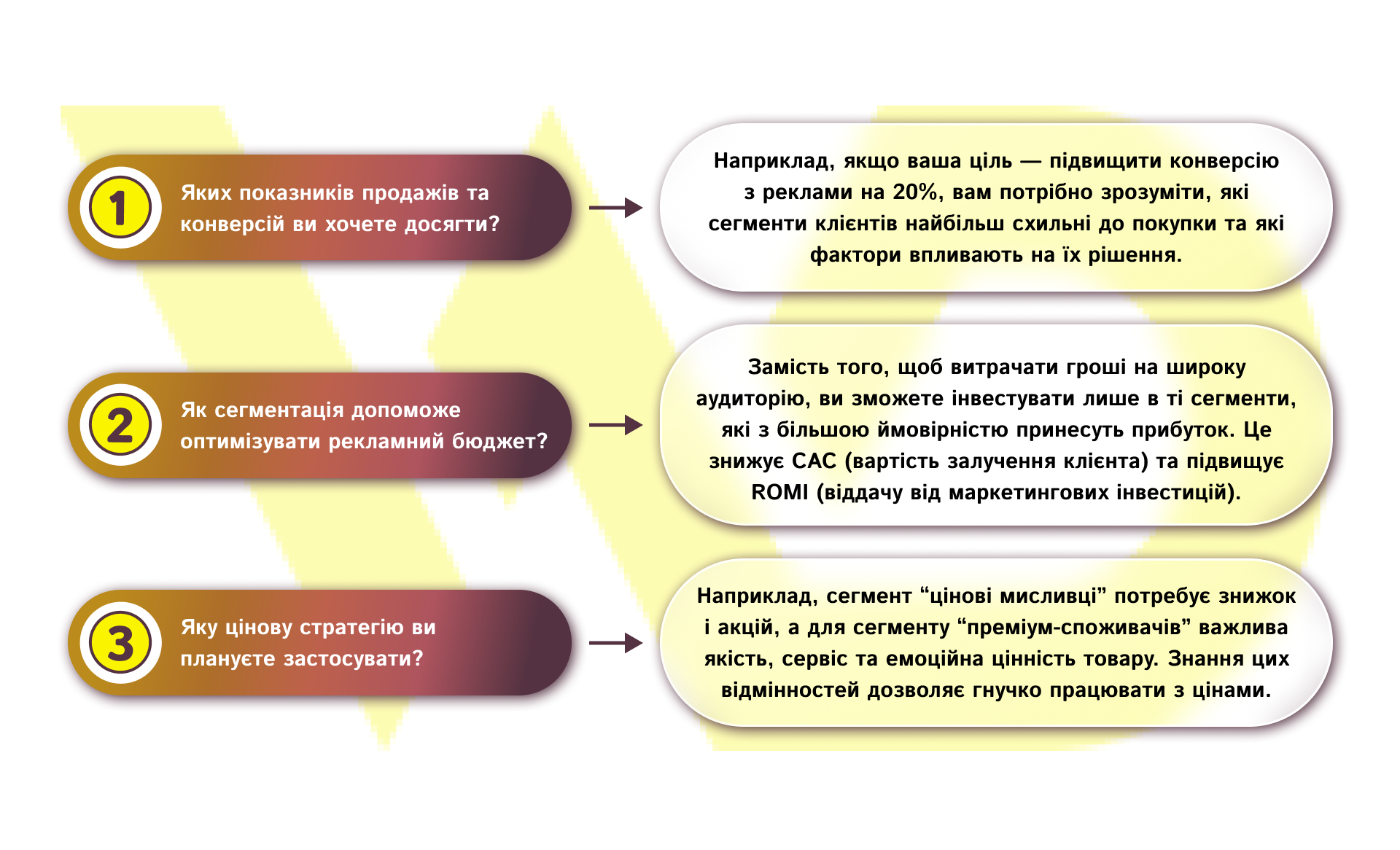
The main tasks of market segmentation
In order to move from general goals to specific steps and ensure a systematic approach, it is worth clearly defining the main objectives of market segmentation.
- Improving consumer understanding.
Market segmentation allows you to move from general assumptions to a clear understanding of your target audience. For example, you may find that young parents are not just looking for a product, but a time-saving solution that is safe and recommended by others.
- Personalization of marketing.
Different segments react differently to content, creative, and communication channels. For one segment, email marketing works, for another, targeted social media advertising with feedback. Personalization increases CTR, conversions, and engagement.
- Resource optimization.
Companies have limited resources – budget, time, and human resources. Market segmentation helps to focus on the most profitable or promising customers. For example, according to the Pareto rule, 20% of customers can generate 80% of profits.
- Increase loyalty.
Relevant offers that «hit the mark» build trust and attachment. Customers who receive personalized solutions are more likely to return, leave positive feedback, and recommend the brand.
Thus, market segmentation is not just a division of the audience into groups, but a strategic tool for achieving business goals. It allows you to build more effective marketing campaigns, more accurately predict demand, reduce costs, and increase ROI. Well-defined segmentation goals and objectives are a navigator in the world of promotion that leads to clearly measurable results.
Principles of successful market segmentation
To make target audience segmentation a real engine of growth, not a formality, you should follow generally accepted principles: from the right choice of criteria to the willingness to implement the results quickly. Below are five basic principles for effective market division.
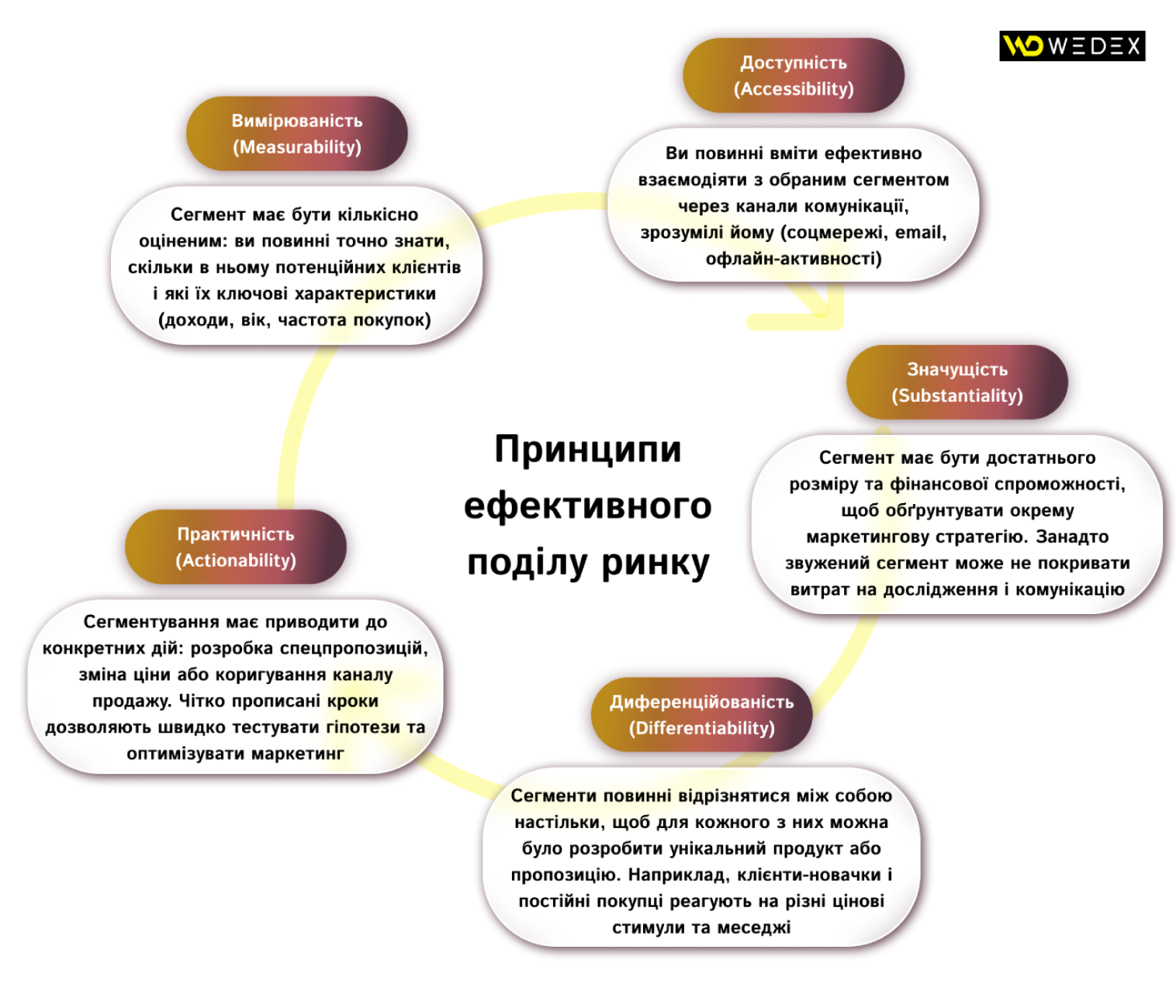
Adherence to these principles ensures that you get clear, manageable, and measurable market segments. It is on their basis that you should build further marketing activities, from pricing to communication campaigns. This significantly increases the return on every hryvnia spent and allows you to quickly adapt to market changes.
Advantages and disadvantages of market segmentation
Understanding the strengths and weaknesses of market segmentation will help you build an effective strategy and avoid common mistakes at the analysis stage.
Advantages of market segmentation
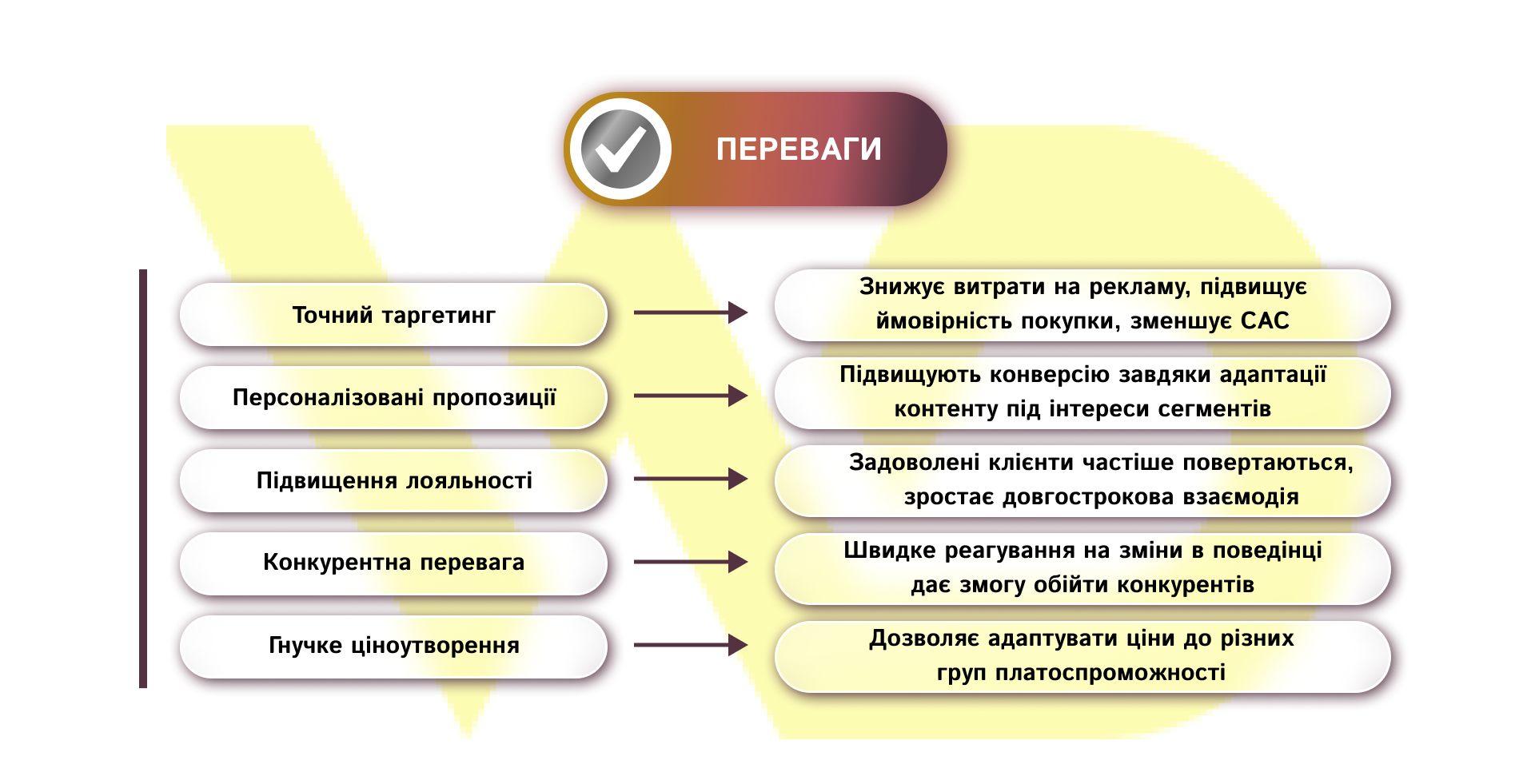
Market segmentation creates clear groups of consumers with similar needs, which allows you to focus your efforts. This not only increases the efficiency of communications, but also contributes to a more accurate allocation of company resources.
Precise targeting
Thanks to a clear division of the audience into groups, advertising messages reach those customers who are most likely to make a purchase. This allows you to avoid unnecessary costs for reaching a «wide» audience and reduce CAC (cost per acquisition). If a company implements market segmentation, it saves its advertising budget and can direct investments to those target audiences that generate the most revenue.
Personalized offers
Market segmentation allows you to adapt the content, format, and price offer to the specific interests and needs of each group, and personalized content encourages consumers to buy more often and, as a result, increases conversion.
Increase loyalty
When customers receive relevant products and promotional offers, they demonstrate higher levels of satisfaction and brand loyalty. Since repeat customers generate significantly more revenue than new ones, it is important to establish regular, personalized communications that build trust and create long-term relationships.
Competitive advantage
In a saturated market, companies that quickly track changes in the preferences of different consumer groups gain an important competitive advantage. For example, if you quickly identify price hunters and launch promotional offers for them, you can capture their market share before competitors have time to adapt.
Flexibility in pricing
Using market segmentation, you can apply different pricing strategies: premium positioning for one target audience and affordable packages for another. This helps to maximize revenue and cover a wider range of audience solvency.
Disadvantages of market segmentation
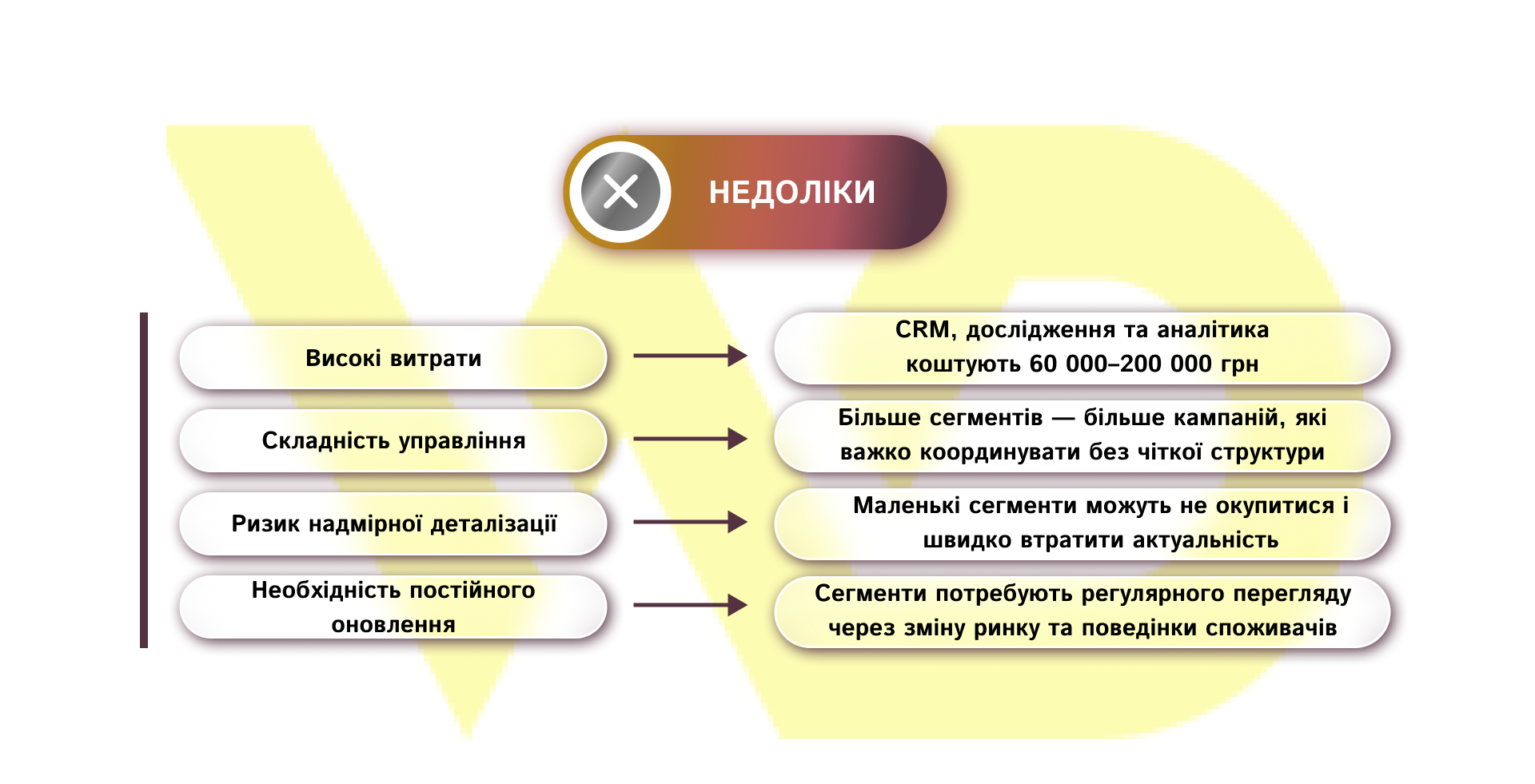
While market segmentation opens up great opportunities, it also requires careful planning and resources to keep the data up-to-date. Before starting the research, you should find out and evaluate all possible disadvantages.
Costs
High-quality market segmentation requires investments in CRM systems, analytics, surveys, and focus groups. According to the article «How Marketing Research Influences Business Decision Making«, in 2023-2024, a simple online survey (1,000 respondents) cost about UAH 15,000-25,000. And according to the article «Conducting Marketing Research – the Cost is Determined by the Customer«, a comprehensive turnkey marketing research with focus groups and in-depth interviews costs from UAH 40,000 to 190,000. The total cost of market segmentation for an average company is approximately UAH 60,000-200,000.
Complexity of management
The more target groups you have, the more different campaigns you need to plan, budget, and control. Without the right tools and clear processes, this can lead to a waste of resources and chaos in the work of teams.
Risk of over-detailing
Creating too small micro-segments can be unprofitable: the audience is too small to recoup the costs of personalization. In addition, small target audiences are more difficult to scale, and they can quickly become irrelevant due to changes in consumer behavior.
Spending time on updates
The market and customer needs are changing dynamically, so groups need to be regularly reviewed and adjusted. This requires time and analytical resources, especially in fast-growing markets.
Understanding the advantages and disadvantages will help you balance investments in market segmentation and expected business benefits, ensuring maximum return on your resources.
Key criteria for customer segmentation
For market segmentation to work in practice, you need to choose clear criteria by which you will classify your audience. They will determine how homogeneous each segment will be and how different the groups will be from each other. Remember: the goal is to find the characteristics that influence the customer’s purchase decision and price sensitivity.
First of all, let’s look at the most common criteria:
- Demographics.
This includes age, gender, income, and education. Most companies start market segmentation with demographics, as it gives a clear picture of the audience’s ability to pay. For example, customers aged 25-34 with an average income in big cities are more likely to buy the latest gadgets. Demographic segmentation helps to set the starting price and choose the basic communication channels.
- Geographic.
Region of residence, country, climatic conditions, population density. In the global market, it is important to take into account local peculiarities: from product preferences to the ability to pay. For example, the price of delivery and customs fees differ significantly for residents of the capital and rural areas. In cold climates, it is better to promote insulated clothing, and in warm climates, lightweight fabrics with UV protection.
- Behavioral.
Consumer activity on the website or in the store, frequency of purchases, brand loyalty, sensitivity to price promotions. Most often, customers expect personalized offers based on their previous behavior. For example, the «regular customers» segment can receive loyalty programs, and «price hunters» can receive special coupons and discounts.
- Psychographic.
Values, interests, lifestyle, and attitudes towards brands. These characteristics allow you to work with the emotional component of the purchase decision. For example, an audience focused on a healthy lifestyle is willing to pay a higher price for organic products and fitness trainer services. Psychographic market segmentation allows you to develop expert messages and emphasize the social status of the consumer.
- Technological (additional criterion).
The level of technology proficiency, use of mobile devices or applications. According to the latest Gauss report (2024), in 2023, 72% of global e-commerce sales were on mobile devices, and by 2027, this share is projected to reach 88%. Mobile shoppers will respond to push notifications and a simplified payment process.
Clearly defined segmentation criteria allow you to get real customer portraits, adapt the price and communication channels to each segment, and most importantly, create offers that the audience will perceive as most relevant. After all, any example of successful market segmentation begins with the right choice of market division criteria.
Stages of market segmentation
To turn market segmentation from a theoretical scheme into a real growth tool, you need to go through several clear stages. Each of them helps to gradually transform scattered customer data into structured audience portraits and proven business hypotheses.
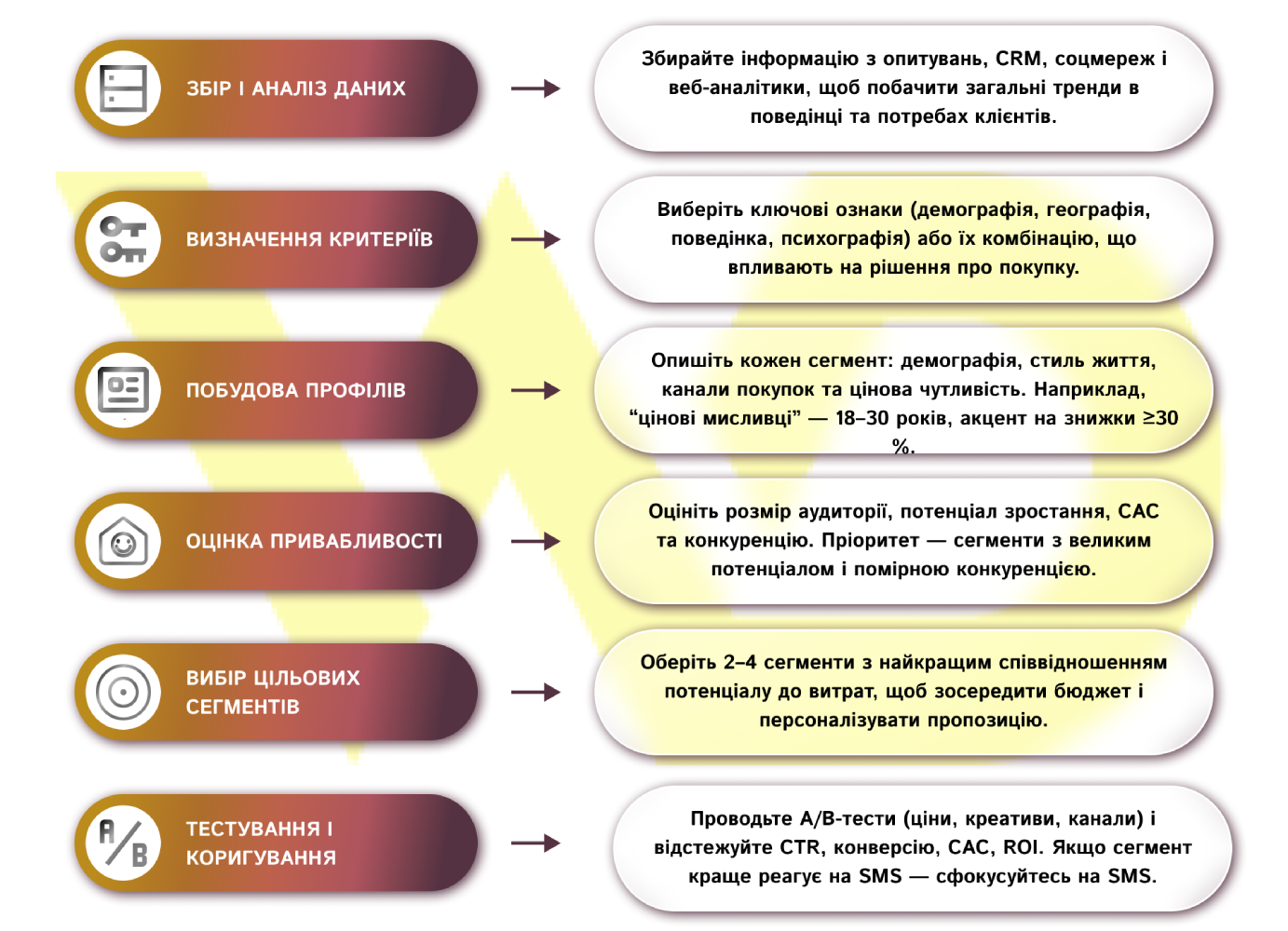
- Data collection and preliminary analysis.
The first step is to accumulate all available customer data. You can use
- surveys (online and offline) to find out motivation, pains, and expectations;
- CRM systems that store order history, communication channels, and customer reactions;
- social networks (Facebook, Instagram, LinkedIn) to identify interests, activity, and feedback;
- web analytics (such as Google Analytics) to understand the customer journey on the website.
The purpose of this stage is not only to collect a «picture» of the purchase, but also to analyze trends: for example, which products are viewed but not purchased, or at what time of day customers are most active.
- Define market segmentation criteria.
Based on the collected data, choose the division criteria that have the greatest impact on the purchase decision. We have already talked about them above. These are demographic, geographic, behavioral, and psychographic criteria. In most cases, successful cases combine several criteria, for example, «young parents» + «buyers with discounts of more than 20%».
- Building segment profiles.
Here you form a portrait of each segment – a detailed description that helps marketing and sales teams «see» the customer alive. The profile should include:
- basic demographic data (age, gender);
- lifestyle and values (what is important in life)
- behavioral habits (how often and through which channels they buy);
- expected price and sensitivity to discounts.
For example: the «price hunters» group. Age 18-30, live in big cities, look for promotions and bargains, most often buy with a discount of ≥30%.
- Assessing the attractiveness of segments.
Not all segments should be worked on equally. Evaluate each by the following factors:
- audience size – how many potential buyers are in the target group;
- growth potential – how fast this target audience can grow;
- cost of entry – the cost of attracting one customer (CAC);
- competitive market – how many players are already working with this segment.
Segments with high potential, low entry costs, and moderate competition should be prioritized.
- Selection of segments.
Based on the assessment of attractiveness, select 2-4 segments to which you should direct your main resources. Focus will reduce budget dispersion, increase the depth of personalization, and provide faster feedback on campaign results.
- Testing and adjustments.
Even after the campaigns are launched, the work is not over: to optimize your performance, test different price levels and promotional offers, variants of creatives and texts in ads, as well as communication channels (email, social media, context). Keep track of key metrics (CTR, conversion, CAC, ROI) and quickly adjust your strategy: if, for example, your group responds better to SMS campaigns, focus on this channel.
Following these steps helps to gradually build a deep and reliable portrait of each segment, select the most promising customer groups, and turn the insights into specific marketing actions that bring tangible results.
Developing marketing strategies based on segmentation
After identifying the segments, the next step is to develop a separate product promotion plan for each of them that takes into account their unique needs and behavioral characteristics. Let’s analyze what exactly needs to be done.
- Formulate the key message. For each segment, you need to specify what kind of solution to the problem you offer. For example, for the «price hunters» target audience, the message may sound like this: «Buy your favorite brands at a bargain – weekly discounts of up to 40%», and for «premium consumers»: «Exclusive service and same-day delivery».
- Choice of communication channels. Not all groups use the same platforms. Young people respond better to Instagram Stories, Reels, TikTok, Threads, while company executives respond better to LinkedIn and professional email newsletters. Also, young people aged 18-25 regularly read messengers before email, so for this group, you should focus on Viber or Telegram channels.
- Formation of the offer. The set of products, additional services, and price should meet the expectations of each group. For example, for «beginners» in SaaS products, it is recommended to launch a trial tariff with limited functionality for 0 UAH, and for the «advanced» segment, offer a comprehensive package with personal support at a higher price.
- Hypothesis testing. A/B testing allows you to quickly check which versions of headlines, images, or price offers work best. For example, during one of its tests, the online store Zootovary.com identified the «pet lovers« segment: customers who often buy food and accessories for specific breeds. Two versions of the triggered email were compared in an A/B test: the first contained personalized recommendations from («Did your pet like the new food?»), and the second contained a general promo code without regard to breed or preferences. As a result, the personalized email showed a 30% higher open rate and generated additional revenue, which grew by 30% in a month.
- Optimization and scaling. Based on the data obtained, compare the results with the expected KPIs: ROI, CAC, CR (conversion rate). If the indicators are lower than planned, adjust the message, channels, or offer. Over time, successful tactics can be scaled to other segments or regions.
Developing a marketing strategy based on market segmentation is an iterative process that includes hypothesizing, testing, and adjusting. It is this approach that helps you create relevant offers that resonate with each segment of your audience and ensures systematic sales growth.
Cost and profitability of market segmentation
Evaluating the cost-effectiveness of market segmentation starts with understanding how much it costs to implement it and ends with measuring how well the investment has paid off.
In Ukraine, a basic market research commissioned from freelancers can be ordered at a price of UAH 1,000 to 10,000 per project, depending on the scope of analysis and sample size. If you need a comprehensive turnkey study with focus groups and in-depth interviews, companies will spend from UAH 40,000 to 190,000, depending on the number of respondents and the complexity of the methodology.
The infrastructure for data processing and storage deserves special attention. For example, a perpetual boxed license of Perfectum CRM+ERP for 5 users costs UAH 36,000, and for 10 users – UAH 50,400 (for advanced packages, the price increases to UAH 72,000 for 20 users). An alternative SaaS solution, HelperCRM, offers full functionality for up to 5 users for 400 UAH per month or 1,200 UAH for three months (≈ 400 UAH/month) with free additional months. For online stores, the popular CRM SalesDrive costs 733 UAH/month for 1-2 users with quarterly payments, or 677 UAH/month with a yearly prepayment (minimum annual package for 2 users).
To justify these costs, you need to calculate profitability. For this purpose, three basic indicators are used.
- Change in the average check (ΔAverage Check) – how much the average revenue per customer has increased after the start of market segmentation.
- Change in the cost of customer acquisition (ΔCAC) – savings or additional costs for attracting one customer.
- Change in lifetime value of a customer (ΔLTV) is the increase in total revenue from a customer over the entire period of his or her cooperation with the company.
They are used to calculate the ROI of market segmentation using the formula:

First, we calculate the additional income generated by the increased average check, reduced cost of acquisition, and increased LTV. Then, the total costs of research, CRM/BI implementation, and specialist fees are subtracted from this amount, and finally, the ratio of the result to the costs gives the payback percentage.
This approach allows not only to clearly justify the budget for market segmentation, but also to track which elements of the process bring the most profit. For example, the cost of a CRM license can be quickly recouped if it is the increase in sales department productivity that leads to a significant increase in the average check. On the other hand, in-depth research only pays off when the results allow you to adjust pricing and communication so that customers start buying more often and at a higher price.
Examples of how market segmentation is used
Below are three real-life cases of Ukrainian brands that have shown significant results thanks to competent audience segmentation.
BROCARD: detailed segmentation of the customer base for personalized communication
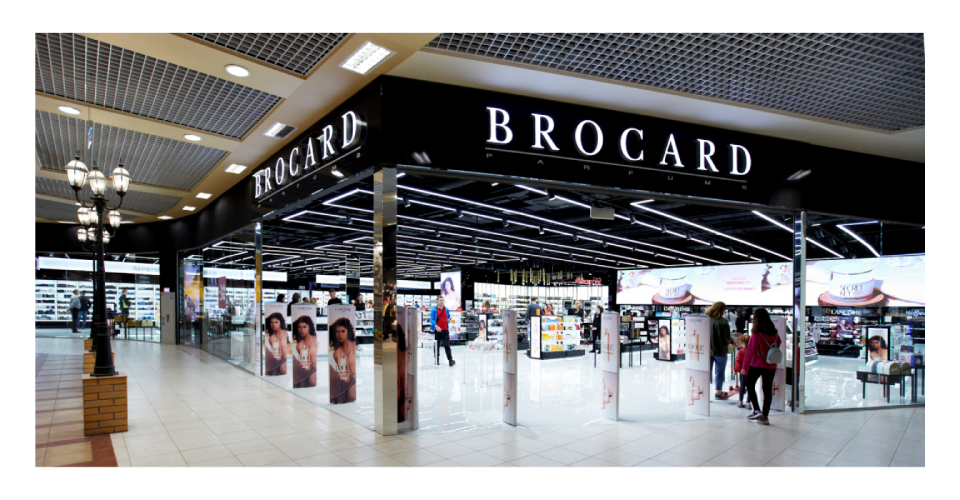
BROCARD, one of the leading perfume and cosmetics chains in Ukraine, faced the need to target its sales efforts more accurately. The company combined data from various sources – offline and online sales, loyalty programs, email campaigns – into a single platform and identified microgroups by purchasing behavior, average check, and interaction channels.
Thanks to this, they managed to
- Reduce the cost of mailing by 30% by stopping spam in «non-target» groups;
- Increase email open rate by 45% and achieve a CTR of 12% in new micro-segments;
- increase the ROI of campaigns in the target group of premium customers by 20%.
These results demonstrated that deep market segmentation and proper data management can significantly improve the effectiveness of communications and lay a solid foundation for further sales growth and customer loyalty.
monobank: user segmentation to grow the customer base and loyalty
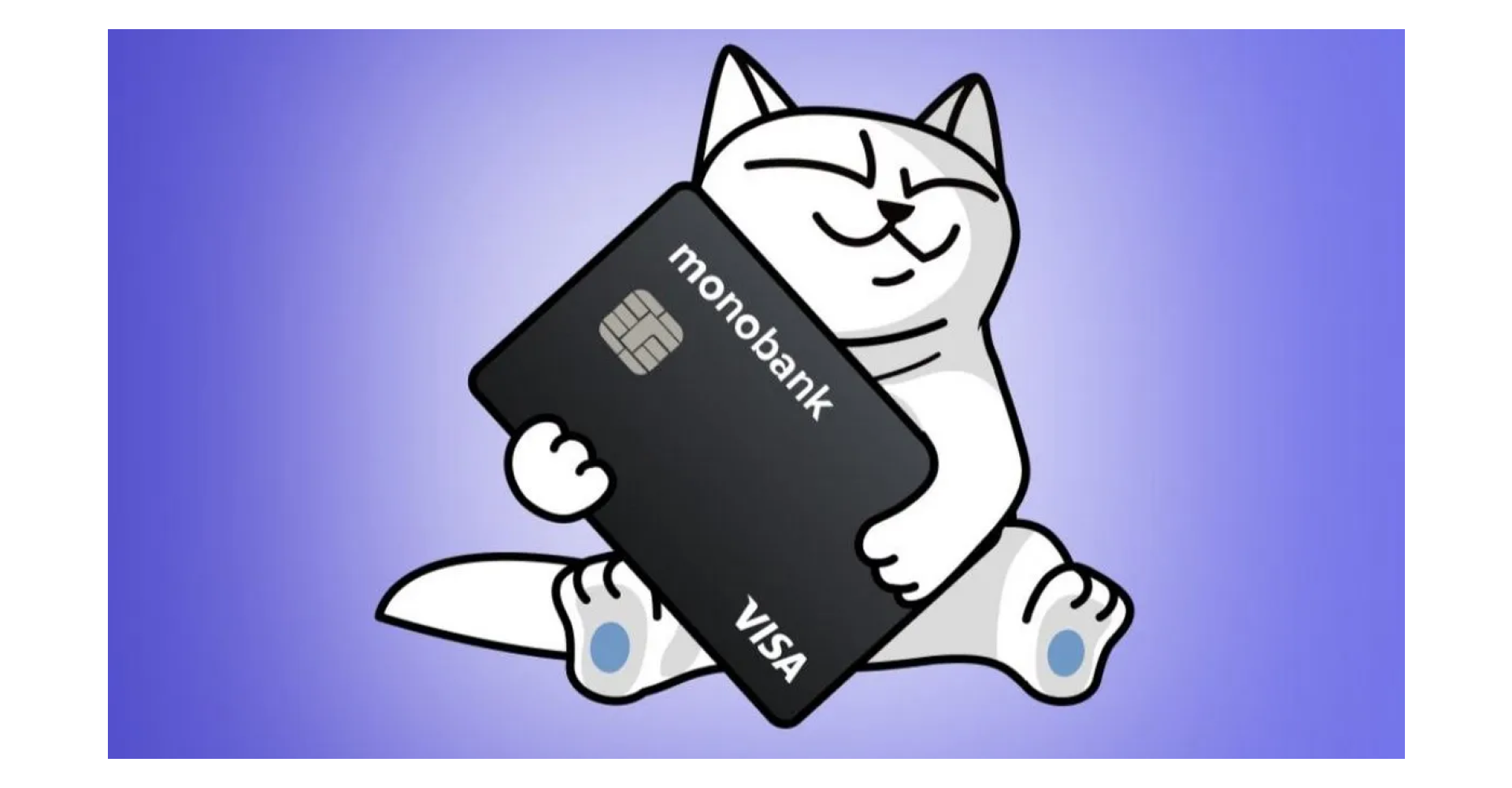
Non-bank monobank has built its strategy on a deep division of its audience into the following segments:
- «Newbies» – users who have just installed the app;
- «Active» – those who use the card at least three times a month;
- «Loyalists – holders of tariffs with increased cashback and additional services.
Thanks to this classification, monobank adapted its communication and product offerings: it sent an introductory series of tutorial emails to newcomers, push notifications about cashback promotions to active customers, and VIP invitations to private webinars to loyalists. The results were
- 25% increase in monthly user activity;
- increase in average LTV by 30%;
- a 40% increase in the share of repeat transactions among «active» groups.
You can read about the methods of market segmentation and the results of monobank’s work on the audience in the qualification work of the National University of Kyiv-Mohyla Academy.
Rozetka: content segmentation by product groups to increase sales from social networks
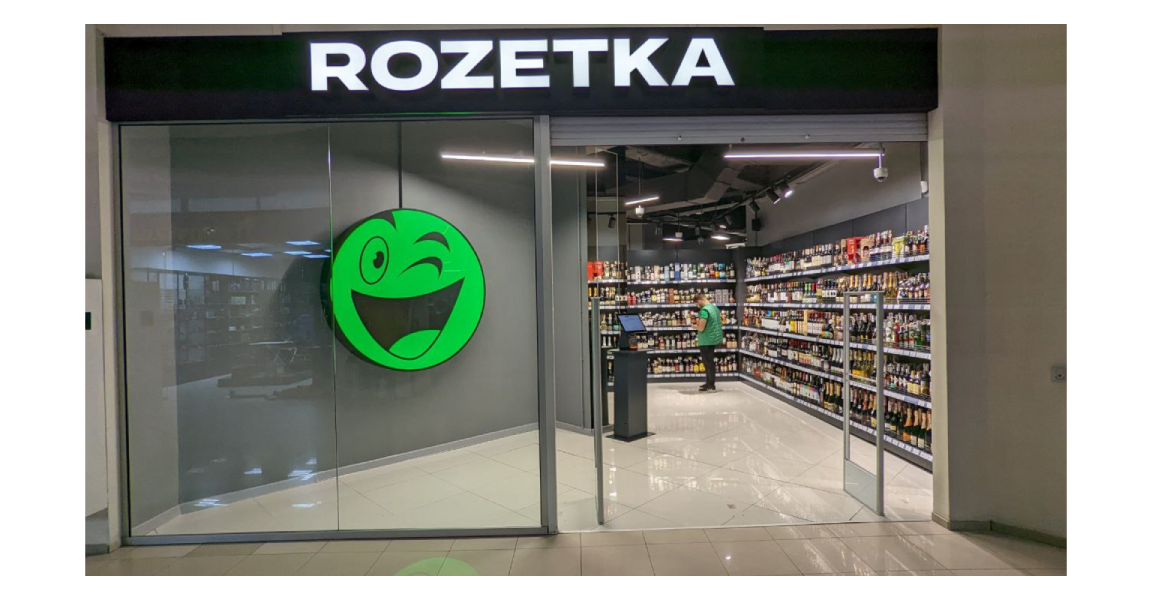
The last example is the case of online retailer Rozetka. The store divided its audience of Facebook and Instagram subscribers into several segments based on their interests in different product categories (electronics, household goods, goods for children, etc.). For each segment, a separate content plan was created: parents were offered reviews of toys and children’s furniture, tech enthusiasts were offered gadget tests and tech life hacks, and owners were offered interior design tips.
After six months of such targeted premium reviews and life hacks, revenue from social media click-throughs increased by 88%, and the average cost per user dropped by 22%.
Conclusion
Market segmentation is a fundamental tool for understanding customers, optimizing prices, and increasing promotion efficiency. Thanks to clear criteria, principles, and stages of analysis, you can create relevant offers for each category of customers. Even with significant costs for data collection and analysis, the profitability of market segmentation projects proves to be worthwhile in the form of an increased average check, reduced cost of customer acquisition, and increased loyalty. Constantly reviewing your target audience and adjusting marketing strategies will help your business grow successfully in a dynamic market.






 19/09/2025
19/09/2025  1246
1246



